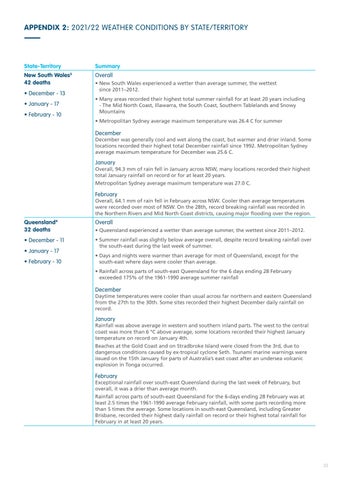APPENDIX 2: 2021/22 WEATHER CONDITIONS BY STATE/TERRITORY
State-Territory
Summary
New South Wales3 42 deaths
Overall
• December - 13 • January - 17 • February - 10
• New South Wales experienced a wetter than average summer, the wettest since 2011–2012. • Many areas recorded their highest total summer rainfall for at least 20 years including - The Mid North Coast, Illawarra, the South Coast, Southern Tablelands and Snowy Mountains • Metropolitan Sydney average maximum temperature was 26.4 C for summer
December December was generally cool and wet along the coast, but warmer and drier inland. Some locations recorded their highest total December rainfall since 1992. Metropolitan Sydney average maximum temperature for December was 25.6 C.
January Overall, 94.3 mm of rain fell in January across NSW, many locations recorded their highest total January rainfall on record or for at least 20 years. Metropolitan Sydney average maximum temperature was 27.0 C.
February Overall, 64.1 mm of rain fell in February across NSW. Cooler than average temperatures were recorded over most of NSW. On the 28th, record breaking rainfall was recorded in the Northern Rivers and Mid North Coast districts, causing major flooding over the region.
Queensland4 32 deaths
Overall
• December - 11
• Summer rainfall was slightly below average overall, despite record breaking rainfall over the south-east during the last week of summer.
• January - 17 • February - 10
• Queensland experienced a wetter than average summer, the wettest since 2011–2012.
• Days and nights were warmer than average for most of Queensland, except for the south-east where days were cooler than average. • Rainfall across parts of south-east Queensland for the 6 days ending 28 February exceeded 175% of the 1961-1990 average summer rainfall
December Daytime temperatures were cooler than usual across far northern and eastern Queensland from the 27th to the 30th. Some sites recorded their highest December daily rainfall on record.
January Rainfall was above average in western and southern inland parts. The west to the central coast was more than 6 °C above average, some locations recorded their highest January temperature on record on January 4th. Beaches at the Gold Coast and on Stradbroke Island were closed from the 3rd, due to dangerous conditions caused by ex-tropical cyclone Seth. Tsunami marine warnings were issued on the 15th January for parts of Australia’s east coast after an undersea volcanic explosion in Tonga occurred.
February Exceptional rainfall over south-east Queensland during the last week of February, but overall, it was a drier than average month. Rainfall across parts of south-east Queensland for the 6-days ending 28 February was at least 2.5 times the 1961-1990 average February rainfall, with some parts recording more than 5 times the average. Some locations in south-east Queensland, including Greater Brisbane, recorded their highest daily rainfall on record or their highest total rainfall for February in at least 20 years.
35






